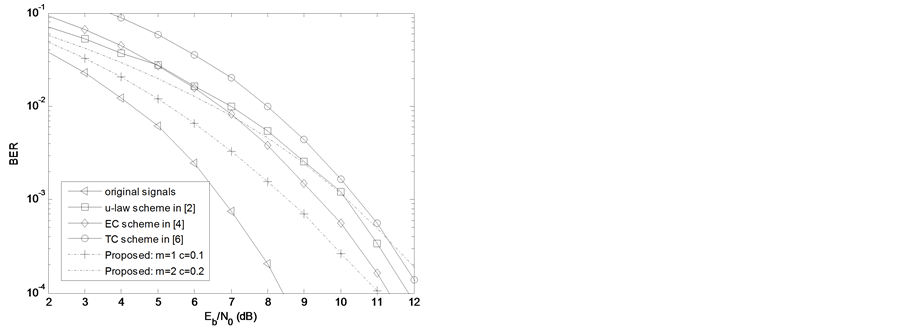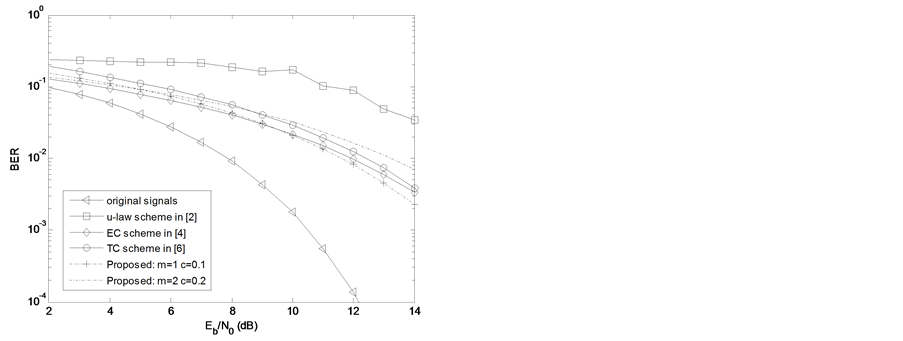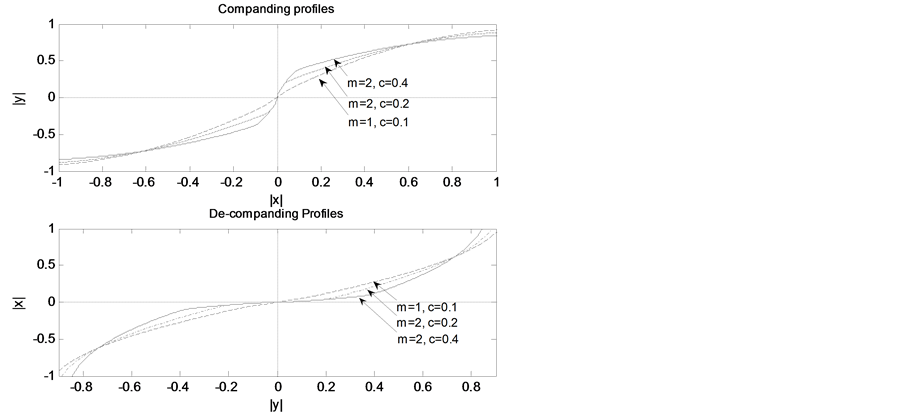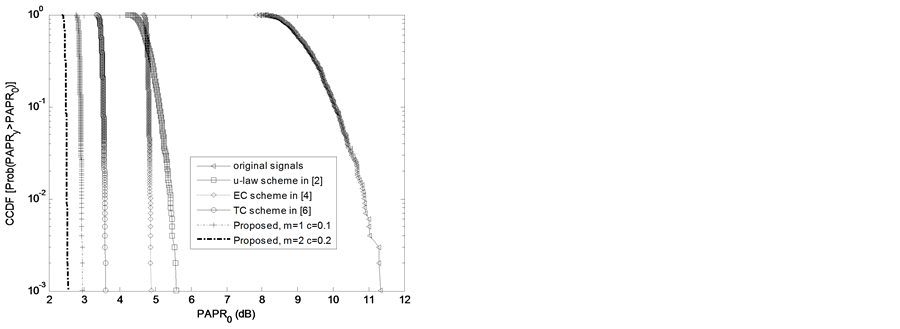International Journal of Communications, Network and System Sciences
Vol.10 No.08(2017), Article ID:78413,6 pages
10.4236/ijcns.2017.108B031
Efficient Nonlinear Companding Transform Scheme for Reducing PAPR of OFDM Signals
Xinguo Li
Shenzhen National Engineering Laboratory of Digital Television Co., Ltd., Shenzhen, China




Received: July 21, 2017; Accepted: August 11, 2017; Published: August 14, 2017
ABSTRACT
Efficient nonlinear companding transform (NCT) scheme for reducing peakto-average power (PAPR) of orthogonal frequency division multiplexing (OFDM) signals is proposed. This scheme transforms the Gaussian-distributed signals into the specified statistics form defined as a piecewise function. By adjusting the transform parameters, it enables more design flexibility in companding form so that a favorable trade-off between PAPR and bit error rate (BER) can be offered. Compared to existing techniques, the scheme can achieve an effective reduction in PAPR as well as an improved BER performance simultaneously.
Keywords:
OFDM, PAPR, NCT, HPA

1. Introduction
Orthogonal frequency division multiplexing (OFDM) technique has been widely adopted in modern wireless communications due to its high spectral efficiency and immunity to the multipath fading effects. However, a critical drawback of OFDM system is the high peak-to-average power ratio (PAPR) of the transmitted signals. The high PAPR results in the in-band distortion and out-of-band interference when the nonlinear power amplifier (HPA) is utilized at the transmitter. Various PAPR reduction methods have been proposed for OFDM systems over the past decade [1], among which, the nonlinear companding transform (NCT) is perhaps the most attractive and significant method owing to its effectiveness and simplicity. NCT belongs to the category of signal pre-distortion solutions for PAPR reduction, and can be employed straightforwardly without any restriction on the OFDM system parameters.
NCT method was first introduced in [2], which used a law companding and can significantly outperform the conventional “hard” clippings. Nevertheless, its average output power is increased after the logarithmic-based compression, which makes itself ever more sensitive to the HPA. Later, the work of [3] pointed out the importance of taking into account the statistics of the companded signals. Recently, a variety of NCT schemes with better performances have been proposed, including the exponential companding (EC) [4], piecewise companding (PC) [5], and trapezoidal companding (TC) [6], etc. However, these schemes are limited under certain bit error rate (BER) performance constraint [7].
Both PAPR and moderate performance degradation are critical challenges for a well-designed companding scheme [8]. In order to obtain efficient PAPR reduction in OFDM systems, this paper proposes a new NCT scheme. By introducing the variable parameters and an inflexion point in the target probability density function (PDF), while remaining an unchanged average power level, the scheme can achieve an effective PAPR reduction as well as an improved BER performance simultaneously. Besides, it also allows more flexibility in the companding form so that a flexible trade-off between PAPR and BER can be offered. Analysis and simulations demonstrate its effectiveness.
2. PAPR Formulation
Suppose the complex-value vector  denotes the frequency-domain OFDM symbol, where N is the number of subcarriers. In the discrete case, the time-domain OFDM signal
denotes the frequency-domain OFDM symbol, where N is the number of subcarriers. In the discrete case, the time-domain OFDM signal  can be represented as
can be represented as
 . (1)
. (1)
Based on the central limit theory, when  is large,
is large,  may be approximated as a complex Gaussian process with zero mean and a common variance
may be approximated as a complex Gaussian process with zero mean and a common variance . Thus, the signal amplitude
. Thus, the signal amplitude  follows a Rayleigh distribution with the PDF as
follows a Rayleigh distribution with the PDF as
 . (2)
. (2)
The PAPR of OFDM signal in a given time-domain symbol is defined as
 . (3)
. (3)
3. Proposed Scheme
In this section we first derive the generic formulas of the proposed scheme. Then, its theoretical performance is characterized with the achievable PAPR gain. The main idea of the scheme is to transform the statistics of the signal amplitude into a specified PDF form defined by a piecewise function with an inflexion point. Assume that the inflexion point and cutoff point of this target PDF are  and
and , respectively. The specified PDF can be expressed as
, respectively. The specified PDF can be expressed as
 . (4)
. (4)
where ,
,  and
and  are the transform parameters that control the companding form i.e. ultimate PAPR, while adjusting the average output power level in the operation. The target cumulative distribution function (CDF) can also be given by
are the transform parameters that control the companding form i.e. ultimate PAPR, while adjusting the average output power level in the operation. The target cumulative distribution function (CDF) can also be given by
 (5)
(5)
From the CDF definition, namely , we have
, we have
 . Given that the proposed companding function
. Given that the proposed companding function


where 

where
is

To reduce the implementation complexity, both functions in Equation (7) and Equation (8) can be numerically pre-computed and performed through the look- up tables in practice. Moreover, in order to keep the input and output signal with an unchanged power level, i.e.

Figure 1 depicts the companding and de-companding profiles of this scheme. As observed, by compressing large amplitude signals while enlarging small ones, both the PAPR reduction and immunity of small signals from noise can be achieved.
The ultimate PAPR of the companded signal with this scheme is given by

where

According to Equation (11), the achievable G in PAPR is more than 7.7 dB.
4. Simulation Results
In this section, we present numerical simulations to evaluate the performance of the proposed scheme. We consider an un-coded OFDM system with the number of subcarriers 






where 
Figure 1. Companding and de-companding profiles.
CCDFs of the PAPR with different schemes for QPSK. As shown in the figure, our scheme can effectively reduce the PAPR while simultaneously obtaining sharp drops in CCDFs.
Figure 3(a) and Figure 3(b) plot the BER versus Eb/N0 curves with different
Figure 2. The CCDFs of the original and companded signals.


Figure 3. BER performance of different schemes over AWGN channel.
schemes over the additive Gaussian white noise (AWGN) channel for QPSK and 16QAM, respectively. As observed, our scheme can obtain better BER performance than the referred schemes. For example, at BER = 10−4 for QPSK, the required Eb/N0 for our scheme with 
5. Conclusion
In this paper, we have proposed and evaluated a new NCT scheme. Both the theoretical analysis and simulations show that it offers an improved BER performance while reducing the PAPR significantly. Moreover, by properly adjusting the transform parameters, a favorable trade-off between PAPR and BER can also be obtained.
Cite this paper
Li, X.G. (2017) Efficient Nonlinear Companding Transform Scheme for Reducing PAPR of OFDM Signals. Int. J. Communications, Network and System Sciences, 10, 293-298. https://doi.org/10.4236/ijcns.2017.108B031
References
- 1. Jiang, T. and Wu, Y. (2008) An Overview: Peak-to-Average Power Ratio Reduction Techniques for OFDM Signals. IEEE Trans. Broadcast., 54, 257-268. https://doi.org/10.1109/TBC.2008.915770
- 2. Wang, X.B., Tjhung, T.T. and Ng, C.S. (1999) Reduction of Peak-to-Average Power Ratio of OFDM System Using a Companding Technique. IEEE Trans. Broadcast., 45, 303-307. https://doi.org/10.1109/11.796272
- 3. Huang, X., Lu, J., Zheng, J., Letaief, K.B. and Gu, J. (2004) Companding Trans-form for Reduction in Peak-to-Average Power Ratio of OFDM Signals. IEEE Trans. Wire- less Commun., 3, 2030-2039. https://doi.org/10.1109/TWC.2004.837619
- 4. Jiang, T., Yang, Y. and Song, Y. (2005) Exponential Companding Trans-form for PAPR Reduction in OFDM Systems. IEEE Trans. Broadcast., 51, 244-248. https://doi.org/10.1109/TBC.2005.847626
- 5. Hou, J., Ge, J.H. and Li, J. (2009) Trapezoidal Companding Scheme for Peak-to- Average Power Ratio Reduction of OFDM Signals. Electron. Lett., 45, 1349-1351. https://doi.org/10.1049/el.2009.2180
- 6. Hou, J., Ge, J., Zhai, D. and Li, J. (2010) Peak-to-Average Power Ratio Reduc-tion of OFDM Signals with Nonlinear Companding Scheme. IEEE Trans. Broadcast., 56, 258-262. https://doi.org/10.1109/TBC.2010.2046970
- 7. Wang, Y., Wang, L.-H. and Ge, J.-H. (2012) An Efficient Nonlinear Companding Transform for Reducing PAPR of OFDM Signals. IEEE Trans. on Broadcasting, 58, 677-684. https://doi.org/10.1109/TBC.2012.2198976
- 8. Wang, Y., Ge, J.-H. and Wang, L.-H. (2013) Nonlinear Companding Transform for Reduction of PEAK-to-Average Power Ratio in OFDM Systems. IEEE Trans. on Broadcasting, 59, 369-375. https://doi.org/10.1109/TBC.2012.2219252



